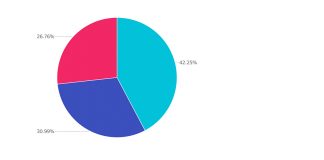Consolidation is dramatically reshaping the dental industry. And with more and more outside capital pouring into dental, this transformation is gathering speed.
As a result, new dental groups and Dental Support Organizations (DSOs) are taking shape every week. In order for these multi-location dental organizations to achieve their full potential, they need an enterprise practice management system that meets their unique needs.
Surprisingly, there aren’t many systems out there that fit the bill, and some of the more well-known names are legacy, desktop systems geared towards solo practices. The best solutions, of which there are only a handful, are the ones built from the cloud-down for multi-location groups and DSOs.
What is cloud-based software?
First introduced in 1999 with NetSuite (an enterprise resource planning solution), one month ahead of Salesforce, cloud-based business software solutions have since become commonplace in most industries as a less expensive, more practical alternative to traditional desktop and server-bound software. Also known as web-based software, cloud solutions are accessed via internet browser, and require no local servers or extensive computer hardware to operate.
Why isn’t everyone on the cloud yet in dental?
According to HiMSS Analytics, 83% of healthcare organizations are already using cloud-based solutions for a variety of reasons including accessibility, centralized control, enhanced security, seamless updates, scalability, and cost savings.
The dental industry is ten years behind when it comes to technology. Some have explained this lag by pointing to the fragmented nature of the industry—indeed, most practices today are still single-location businesses. But the sea change that brought consolidation to the medical industry is now happening in dental, and it will make outdated software untenable given increased competition and a greater need for efficiency and centralization.
Accessibility
Many dental groups, and particularly DSOs, are stuck with a patchwork quilt of legacy desktop systems they inherited from acquired offices. Because these offices aren’t on a centralized system, management has to pull reports from each individual system and then manage to cobble them together for a comprehensive overview of performance at the enterprise level. Many groups and DSOs even feel compelled to hire a full-time employee dedicated to the work of pulling reports from disparate practice management systems to combine them in some intelligible format. There’s no efficiency in that.
With a cloud-based system like Denticon, from PlanetDDS, the company I am with, management can easily toggle between locations online and pull consolidated reports showing performance from the group level down to individual providers and staff.
Centralized control
Good cloud software allows offices to share fee schedules, insurance plans, and other important information across locations seamlessly. Administrators can enter the information once and apply it as they see fit to as many locations as they desire, allowing for powerful, time-saving standardization.
It also gives administrators the power to control access for different user profiles based on job title, function, even geographic location, with a full audit trail to see what users have done in the system. Groups and DSOs can decide when and where staff has access to organizational-level information, or keep staff focused on practice-level information only.
With a centralized database, DSOs get a single patient record and a single provider record if they desire. Patients and providers can travel to different locations without the need for duplicate records. This “concept of one” makes calculating provider compensation a lot easier. And it helps prevent confusion for patients who may have been receiving multiple statements from the same dental organization for each location they visited.
Group and DSO focused cloud-based EMR/PM is ideally suited for centralizing services such as call centers, because all group information can be viewed and modified remotely with the proper admin rights.
Enhanced security
Most HIPAA data breaches occur when physical media is stolen (a thumb drive left unsecured on a desk, or a laptop left in the front seat of a car). With traditional desktop systems, all of a practice’s patient records and other sensitive information is stored locally, on site, on computer hard drives or practice servers. These are vulnerable to theft or damage, even with a solid backup and security routine.
HIPAA breaches have consequences. They can come with heavy fines and require that patients be informed of the breach—never a fun conversation and one that may create legal exposure.
With a HIPAA compliant cloud solution, all practice and patient information is stored remotely, on secure servers in state-of-the-art data centers with full redundancy and continuous backups. This storage method dramatically reduces the risk of breach.
Seamless updates
Another benefit cloud practice management for enterprises is that software updates are performed seamlessly by the software’s developer, behind the scenes. Users simply log in to access the latest version of their software—there’s no need to keep track of license versions and download cumbersome upgrades to a desktop.
Enterprise cloud practice management software should continuously be updated to keep pace with industry and regulatory changes (and the most popular feature requests submitted by users) on a recurring release schedule.
Scalability
Many emerging DSOs have exciting growth plans. Enterprise cloud-based dental practice management solutions are ideally suited to serve your needs because the software is eminently scalable. It doesn’t require extensive new hardware purchases, and new offices can be easily set up online by authorized administrators.
Software should never be a bottleneck to growth.
Significant cost savings
Cloud software is often much less expensive, which may seem surprising given its many advantages over traditional desktop software. This cost advantage has a lot to do with something that is often hidden by desktop software vendors: total cost of ownership. Multi-location desktop, client-server systems require extensive hardware to run, and trained personnel to maintain that hardware. You’re paying the vendor for the software (the advertised cost) but you’re also paying for the backbone to support the vendor’s software (the hidden cost of ownership). Traditional systems require significant up-front capital expenditures just to build out that required infrastructure.
Cloud software, on the other hand, requires little in the way of local hardware beyond computer workstations and internet access. Users log in via web browser, just like they would access a bank account online—via secured, encrypted internet connection.
With Denticon, we have seen emerging groups and DSOs experience an average 56% cost savings over three years after switching to cloud-based Denticon because it eliminates the IT burden associated with client-server desktop software.
Are there drawbacks to the cloud?
Reliable internet is often a concern for businesses evaluating cloud-based software, but nowadays internet connections are very stable across the U.S. On those rare occasions when internet providers experience downtime, it’s usually just temporary. Compare that to the frustration of legacy practice management solutions that are out of action when your desktop computer crashes, and the benefits of the cloud appear even more obvious.
Out of an abundance of caution, some offices will keep a wireless network card on hand to connect to the internet via cellular network in the event of a local internet outage.
Is it time to switch to the cloud?
We already do so much in the cloud in our day-to-day lives, from texting to sharing photos to email to everything else. Most industries have already made the transition from outdated desktop enterprise software solutions to the cloud.
It’s only a matter of time before dental catches up. For dental organizations that are growing, there’s no time like the present to switch to a modern cloud solution. Only then can they truly achieve the full potential inherent in scale.











